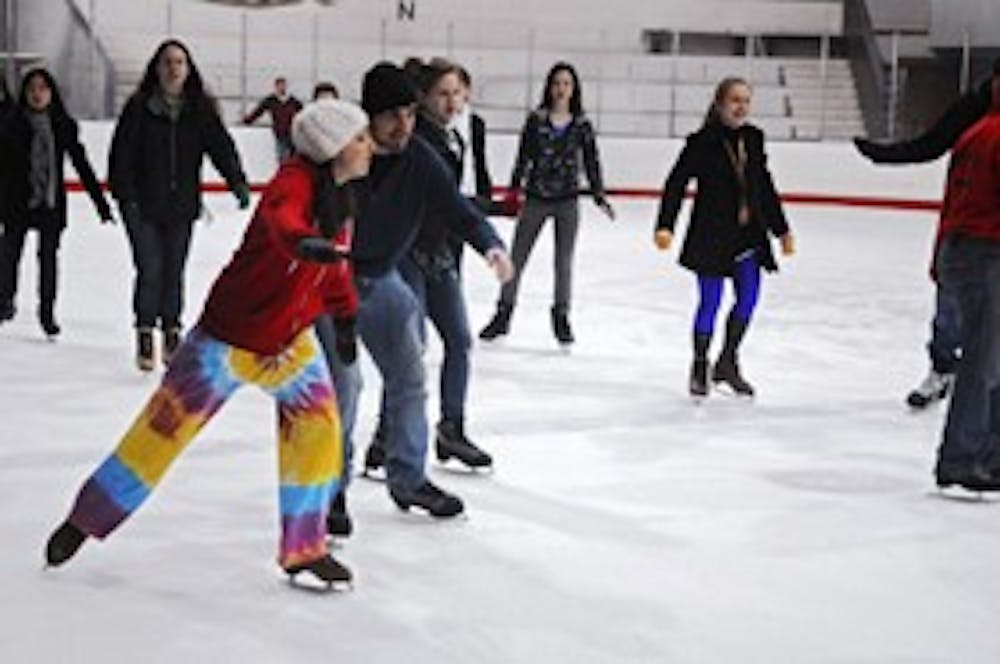
From the outside, the building at 3130 Walnut Street is a mere mass of gray poured concrete, devoid of the beautiful architecture marking the other athletic buildings around the corner.
But inside, the Class of 1923 Arena is experiencing a renaissance of activity as the Olympics remind people just how much fun the ice can be.
Though the 2,900-seat arena is showing the wear and tear that comes with 30-plus years in existence, the crowds inside keep the building youthful.
Ice hockey is growing more popular. Private lesson enrollment is up. Public skate attendance has increased nearly 30 percent compared to last year.
In short, the ice rink is beating the recession.
During a time when deficits and budget cuts are rampant, the rink is actually making enough revenue to pay for itself.
And running a rink isn’t cheap. Though Business Services spokeswoman Barbara Lea-Kruger declined to provide the exact operating costs of the rink, the building is essentially a giant refrigerator through the fall, winter and spring months, closing only during the summer. Electricity comprises one of its top three costs along with maintenance and labor, according to Bryan Isola, associate director of operations for Business Services, who oversees the rink.
But on the revenue side, the University brings in cash from hockey, admissions and skate rentals during open skate, lessons and some concessions, said Lea-Kruger. They also rent ice time and space for birthday parties.
Though rink rental for birthday parties sometimes declines during a recession, revenues from hockey, open skate and lessons invariably increase as the Winter Olympics re-open the public’s eyes to skating every four years.
“Over the last two years in general, we’ve seen an up trend overall,” said Isola. “It’s the fact that we have the Olympics. People will actually skate during a recession.”
Nursing senior Vanessa Briggs, who works at the rink, said parents will often come in and sign their children up for lessons after watching the skating events on TV.
And Scott Tharp, President of the Ed Snider Youth Hockey Foundation, which uses the rink, said enrollment in the program spiked after the U.S. defeated Canada in hockey last week.
In total, hockey brings in about 86 percent of the rink’s revenue, Lea-Kruger said. Additionally, NHL teams often use the rink for practice on days when the Wachovia Center isn’t available.
Although the Olympics have played a natural part in the rink’s success, the University has been making a concerted effort to expand awareness about the facility.
In addition to traditional methods like targeting families in the Center City area, Penn has also undertaken some more unorthodox marketing efforts, like putting a Zamboni and a person dressed in a penguin suit on Locust Walk to hand out flyers.
The rink managers also send out their work-study students to recruit groups to hold events at the rink. In return for their help, students receive a small percentage of revenues brought in by the group.
And the marketing has worked. College junior Marissa Dwyer, who plays for the women’s club hockey team, said she has noticed more clubs holding events at the ice rink.
In spite of its success in recent years, the University hasn’t been able to kick the rumor that it’s about to tear down the ice rink.
When the original Penn Connects plan — the blueprint for Penn’s eastward expansion — was released in 2006, the rink was not a part of the future vision of the campus. The plan had already met resistance from the Penn community during a 2005 town hall meeting while the expansion was being planned. The plan’s release also sparked a petition from the Delaware Valley Collegiate Hockey Conference.
Active protests have died out in recent years, but students are still unsure of the rink’s future.
Facilities and Real Estate Services Vice President Anne Papageorge said the rink will be “a desirable redevelopment site for more intensive uses” as Walnut Street is further developed.
Translation? Yes, they may one day tear down the rink to make way for another type of building.
But Papageorge said that any reconsideration of the ice rink’s status won’t happen until the third and final phase of the Penn Connects project, which is “no earlier than 2020 or 2025.”
Discussions about land redevelopment will be tricky, as the rink provides an important link and service to the community.
And Penn’s ownership of the rink also offers a means of survival for some sports teams.
Penn groups, including the men’s and women’s club hockey teams, pay about half of what the general public does for ice time. And for those teams, which rack up four to six hours per week in the rink, ice time can be expensive. They pay roughly $200 an hour compared to the general public’s $335, though that figure can vary based on the time of day, type of group and activity (skating, hockey or broomball).
The rink also provides discounted ice time to the Ed Snider Foundation, which teaches hockey to inner-city youth.
Tharp said that though the organization would survive by using other facilities if the rink were to shut down, the Penn rink’s central location helps bring in children from West Philadelphia.
Only time will tell what may happen to the rink. But for now it remains a place for Penn teams to show off their skills and members of the community to live out their Olympic-fantasies — or falls — on ice.
The Daily Pennsylvanian is an independent, student-run newspaper. Please consider making a donation to support the coverage that shapes the University. Your generosity ensures a future of strong journalism at Penn.
DonatePlease note All comments are eligible for publication in The Daily Pennsylvanian.




